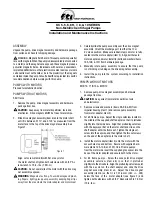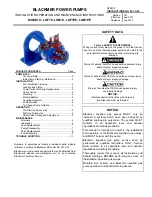
4
it is recommended good practice that all refrigerants are removed safely.
• When transferring refrigerant into cylinders, ensure that only appropriate
refrigerant recovery cylinders are employed. Ensure that the correct number of
cylinders for holding the total system charge is available. All cylinders to be used
are designated for the recovered refrigerant and labelled for that refrigerant (i.e.
special cylinders for the recovery of refrigerant). Cylinders shall be complete with
pressure-relief valve and associated shut-off valves in good working order. Empty
recovery cylinders are evacuated and. if possible. cooled before recovery occurs.
•
The recovery equipment shall be in good working order with a set of instructions
concerning the equipment that is at hand and shall be suitable for the recovery
of all appropriate refrigerants including, when applicable, flammable refrigerants.
In addition, a set of calibrated weighing scales shall be available and in good
working order. Hoses shall be complete with leak-free disconnect couplings and in
good condition. Before using the recovery machine, check that it is in satisfactory
working order, has been properly maintained and that any associated electrical
components are sealed to prevent ignition in the event of a refrigerant release.
Consult manufacturer it in doubt.
• The recovered refrigerant shall be returned to the refrigerant supplier in the
correct recovery cylinder, and the relevant waste transfer note arranged. Do not
mix refrigerants in recovery units and especially not in cylinders.
• If compressors or compressor oils are to be removed. ensure that they have been
evacuated to an acceptable level to make certain that flammable refrigerant does
not remain within the lubricant. The evacuation process shall be carried out prior to
returning the compressor to the suppliers. Only electric heating to the compressor
body shall be employed to accelerate this process. When all is drained from a
system, it shall be carried out safely.
Recycling
This symbol is required by European Community Directive 2012/19/UE on WEEE (Waste Electrical and
Electronic Equipment) and means that your appliance must not be thrown into a normal bin. It will be
selectively collected for the purpose of reuse, recycling or transformation. Any substances it may contain
which are potentially dangerous to the environment shall be eliminated or neutralised. Request information
on recycling procedures from your retailer.
EN
Содержание iAquaLink Z400iQ
Страница 2: ......
Страница 27: ...2 Z400iQ MD7...
Страница 28: ...3 Z400iQ MD8...
Страница 29: ...4 Z400iQ MD9...
Страница 30: ...5 Z400iQ TD7 TD8 TD9...







































